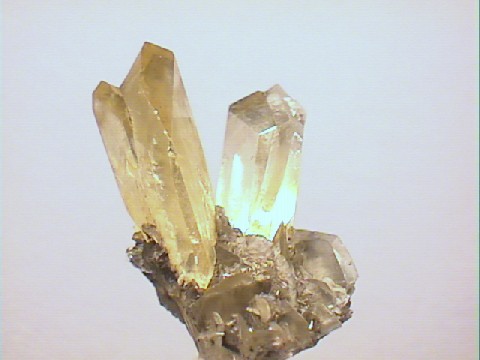
GYPSUM
Specimen gyp-63
$ 25.00
Dims: 1.5 x 1.4 x 1.3" (3.8 x 3.5 x 3.2 cm)
Wt: 1.0 oz. (28 g) w/ base
Red River Floodway, Winnipeg, Manitoba, Canada
Two "split" Gypsum blades extend from the base of much smaller, intergrown crystals of this large thumbnail piece. These crystals are in excellent condition, showing almost no human-induced damage and little natural damage. The larger of the two has dimensions of 1.0 x 1.0 x 0.4" (2.6 x 2.5 x 1.1 cm), and the smaller is only slightly smaller than that. Each has excellent monoclinic bladed form and shows evidence of splitting into two distinct crystals, though the process is incomplete. Their color is a dull, pale yellow and their luster is pearly to greasy. Both are transparent and moderately clear, containing a few internal fractures and inclusions. The base is made up of many smaller blades, but these are either broken or heavily intergrown. The piece is hot-glued to an acrylic base.
 Amethyst Galleries' Mineral Gallery MINERALS |
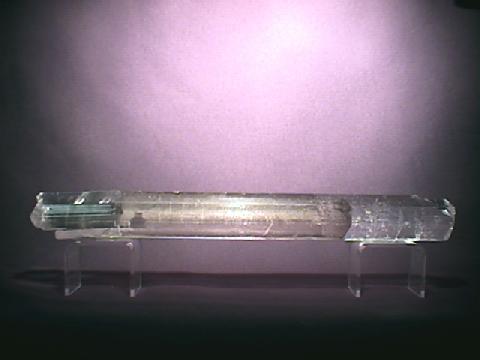
$ 140.00
Dims: 13.2 x 1.6 x 1.1" (33.5 x 4.1 x 2.8 cm)
Wt: 1 lb., 6.4 oz. (635 g)
Chihuahua, Mexico
This magnificent specimen c consists of what appear to be 2 Selenite crystals that are almost perfectly intergrown with each other. Either that, or this piece is made up of a single crystal that has a very odd termination. It has excellent form, however, with well-defined edges and clean but striated faces that show a bright, pearly-to-vitreous luster. It is colorless and transparent, and moderately clear. It also contains a perfectly-formed phantom that appears to be made of a thin layer of limonite. This phantom has such good form that it even imitates the exact shape of the odd termination that stopped growing almost 3.5" (8.9 cm) from it (see the close-up image)! Close examination will show that there is another, fainter phantom between the limonite phantom and the crystal's termination that is made up of either air bubbles or tiny, white selenite sprays that were overgrown. This is one of the most impressive Selenite specimens that I have ever beheld!
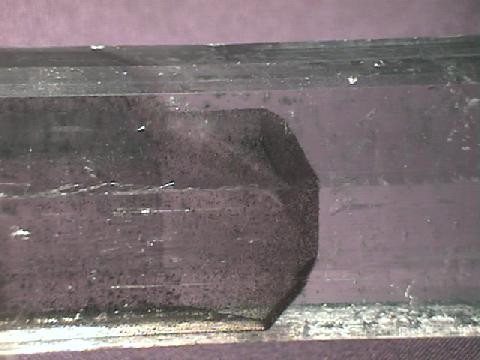

Chihuahua, Mexico
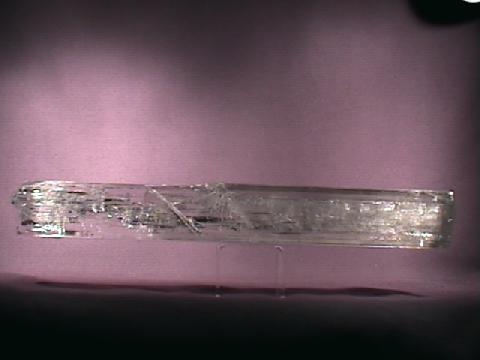
GYPSUM specimen gyp-24
$ 145.00
$ 145.00
Dims: 14.0 x 1.7 x 1.5" (35.6 x 4.3 x 3.8 cm)
Wt: 2 lbs., 8.4 oz. (1.146 g)
Chihuahua, Mexico
This large specimen is similar to the specimen GYP-23 in that it consists of a single, large crystal that contains a noticeable phantom. It shows excellent monoclinic prismatic form with an almost rectangular cross-section, and appears to be twinned. Its termianation is complex and consists of at least 2 different, intergrown crystal terminations. Its edges are well-defined ,and its faces are striated but clean and show a bright, vitreous luster. The crystal is colorless, transparent, and moderately clear, as it contains many internal fractures and inclusions. Though only partially visible, several of these inclusions consist of moving air bubbles that denote two-phase inclusions! The crystal is also clear enough for one to see the subtle but visible phantom that is probably made of countless tiny hematite inclusions. Again, the phantom's termination seems to match that of the crystal itself. However, it is not very easy to study, as there is a large cavity in that area of the crystal that was caused by the separation of another crystal that was partially intergrown with this one.
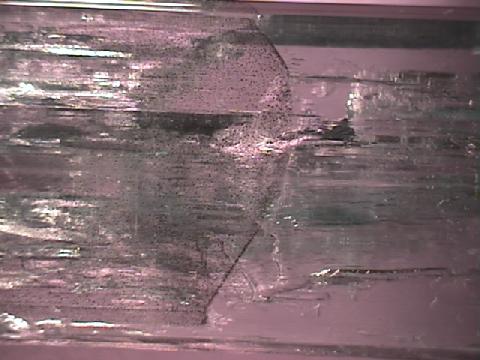

gyp-24 ($145.00)
Chihuahua, Mexico
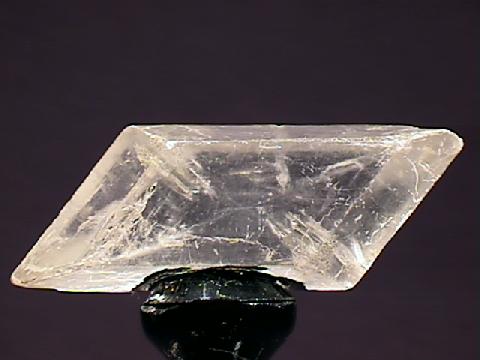
GYPSUM specimen gyp-25
$ 45.00
$ 45.00
Dims: 2.0 x 0.7 x 0.6" (5.1 x 1.8 x 1.5 cm)
Wt: 25.4 g w/ stand
Ellsworth, Ohio, U.S.A.
This small Selenite specimen looks much like those twinned, double-terminated crystals that we get from the Willow Creek locality in Alberta, Canada. Actually, it is almost exactly like them. It has the same excellent monoclinic prismatic form, and though it does show some noticeable damage, this damage is minimal, and does not really affect the crystal's form. Its edges are well-defined and its faces are clean, showing a pearly luster. The crystal is colorless, transparent, and quite clear, though it does contain many visible internal fractures, several of which contain impurities. Under longwave ultraviolet light, it shows the same glowing "quadrants" that the Canadian specimens do (see the close-up image). It is affixed to a rather old-looking stand that is painted black. Unfortunately, the painter did a sloppy job and got paint on the crystal. I did not want to risk breaking the specimen by trying to remove it and clean off the paint.
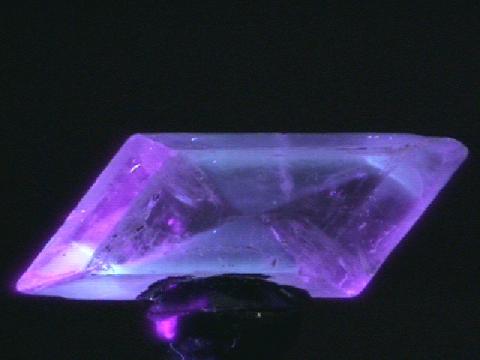

gyp-25 ($ 45.00)
Ellsworth, Ohio, U.S.A.
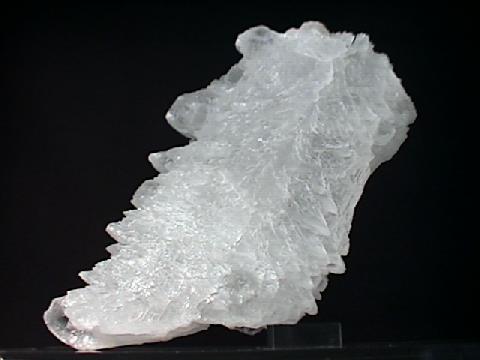
GYPSUM specimen gyp-27
$ 30.00
$ 30.00
Dims: 6.6 x 3.2 x 2.1" (16.8 x 8.1 x 5.3 cm)
Wt: 2 lbs., 2.0 oz. (964.0 g)
Chihuahua, Mexico
This large hand specimen consists of a formation of Fishtail Selenite, as the general outline and patterns on such pieces often resemble the tails of fish. The specimen is in moderately good condition, as it shows many spots of minor damage and a few spots of moderate but more severe damage. Its form is complex and appears to be very good, with well-defined edges and faces that show intense patterning due to growth and intergrowth of the crystals growing off of the twinning plane. It is colorless, has a pearly luster, and is transparent, though its clarity ranges from high to dim as one approaches the twinning plane from either side. There is no host rock present.
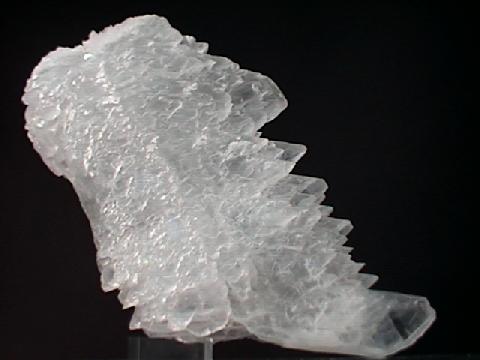

gyp-27 ($ 30.00)
Chihuahua, Mexico
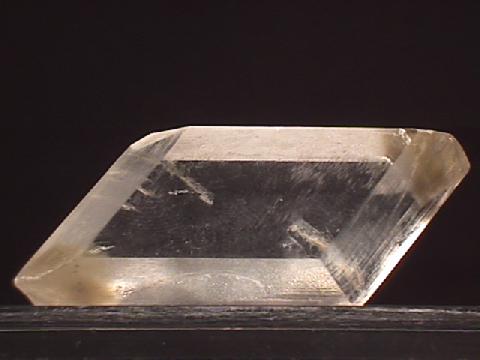
GYPSUM specimen gyp-31
$ 60.00
$ 60.00
Dims: 2.2 x 1.3 x 0.6" (5.6 x 3.3 x 1.5 cm)
Wt: 19.6 g
Willow Creek, near Nanton, Alberta, Canada
This thumbnail specimen consists of a single, double-terminated Selenite prism. It is in near-perfect condition, showing almost no visible human-induced damage, and has exceptional monoclinic prismatic form, with well-defined edges and slightly striated but extremely clean faces that possess a pearly luster. The Selenite is colorless, transparent, and very clear, though it does contain a few inclusions. Some of these consist of parallel, planar internal fractures that contain a small amount of a greenish-brown impurity, but two of the inclusions are made up entirely of this impurity and are aligned opposite each other, along the two main acute angles of the prism. Their shapes are definitely geometrical, so these could, in effect, be called phantoms. They provide only minor interference in seeing the glowing "quadrants" that these crystals show under shortwave UV light.


gyp-31 ($ 60.00)
Willow Creek, near Nanton, Alberta, Canada
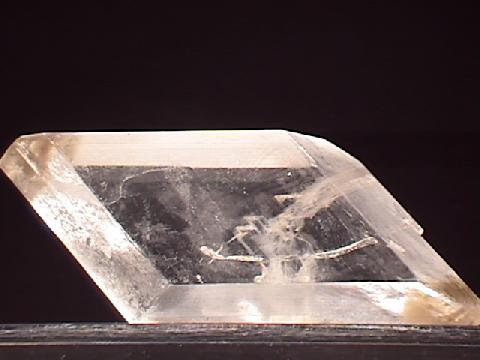
GYPSUM specimen gyp-33
$ 75.00
$ 75.00
Dims: 2.3 x 1.1 x 0.8" (5.8 x 2.8 x 2.0 cm)
Wt: 1.4 oz. (39.1 g)
Willow Creek, near Nanton, Alberta, Canada
This large thumbnail specimen consists of a single monoclinic Selenite prism. It is in excellent condition, showing almost no human-induced damage. Its form is likewise excellent, with well-defined edges and very clean faces that possess the standard pearly luster. There is one obvious growth irregularity that extends across one of its largest faces. It is colorless, transparent, and mostly very clear; however, It does contain several inclusions and a few internal flaws, one of which is caused by the imperfection in its face. At least 4 others are caused by other growth-related imperfections. Two greenish-brown cloudy inclusions tint the material just beneath the two main acute angles of the prism- these are effectively in a phantom form, and I cannot identify the impurity. Like all such specimens from this locality, there is no host rock present.
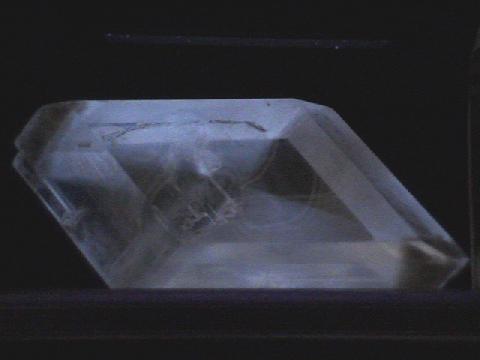

gyp-33 ($ 75.00)
Willow Creek, near Nanton, Alberta, Canada
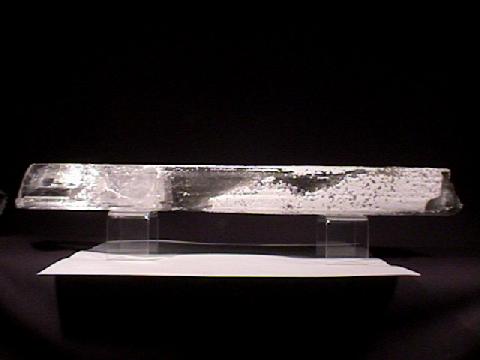
GYPSUM specimen gyp-34
$ 240.00
$ 240.00
Dims: 16.2 x 1.5 x 1.5" (41.1 x 3.8 x 3.8 cm)
Wt: 3 lbs., 2.3 oz. (1.4 kg)
Chihuahua, Mexico
This large Selenite crystal is in excellent condition, showing only one or two areas of slight damage. Its monoclinic prismatic form is very good, though its termination is disjointed into several small faces that are scattered over 3" (7.5 cm) of the length of the crystal. Their edges are well-defined and their faces are striated and moderately clean- a relatively thin crust starts to form only about 5" (13 cm) from the termination, and covers most of the surface from that point down to the base. This crust is made up of countless intergrown sprays of tiny Selenite needles, most of which are compact in form and rather crushed. The Selenite crystal is colorless, transparent, and moderately clear, containing substantial internal fractures. It also contains thousands of tiny dendritic goethite or hematite formations that are aligned so as to create a large phantom that extends from the base to about 5" (13 cm) from the termination. I am thinking that maybe there is some type of a relation to the length of the phantom and that of the crust that covers most of the crystal.
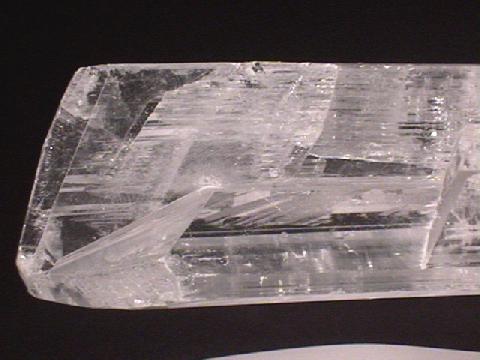

gyp-34 ($240.00)
Chihuahua, Mexico
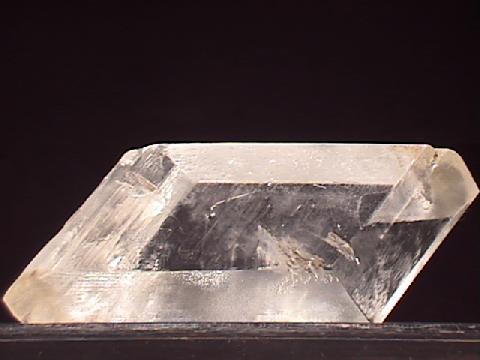
GYPSUM specimen gyp-35
$ 90.00
$ 90.00
Dims: 2.7 x 1.6 x 0.9" (6.9 x 4.1 x 2.3 cm)
Wt: 1.9 oz. (54.0 g)
Willow Creek, near Nanton, Alberta, Canada
This single twinned crystal is not as clear as some of the smaller crystals from this locality that are in our stock, as it contains a few planar, "dirty" inclusions of a fine brown material and a few dirt-filled internal fractures that run along cleavage planes. It is colorless, transparent and still quite clear, however, so that when viewed against a dark background under strong light, one can see two other internal flaws that are otherwise nearly invisible. These flaws consist of extremely narrow gaps that extend into the crystal and run along one of its cleavage planes. Their presence is given away by patches of rainbow-colored iridescence that interfere with clarity only very little. The crystal has excellent, though imperfect form, with well-defined edges and smooth faces that possess the standard pearly luster. Two very small scuff marks are present on the piece; otherwise, it is undamaged and in excellent condition. There is, of course, no host rock.


gyp-35 ($ 90.00)
Willow Creek, near Nanton, Alberta, Canada
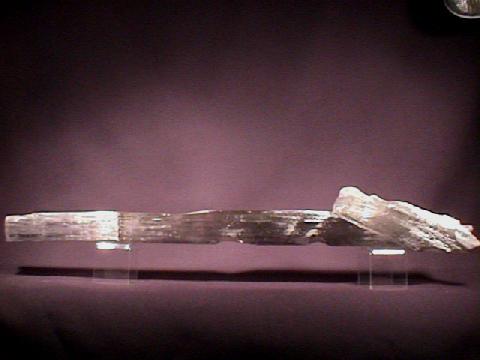
GYPSUM specimen gyp-36
$ 270.00
$ 270.00
Dims: 19.4 x 2.7 x 2.7" (49.3 x 6.9 x 6.9 cm)
Wt: 2 lbs., 10 oz. (1.2 kg)
Chihuahua, Mexico
This specimen is made up of two partly intergrown Selenite crystals. One of these crystals is much smaller than the other, has moderately fair form, and is incomplete. It is much smaller than the other crystal, whose dimensions are 19.4 x 1.7 x 1.1" (49.3 x 4.3 x 2.8 cm). This larger crystal shows some damage that was caused by separation from other crystals, but is still in good condition with an intact termination. Separating other crystals from the specimen has left geometric indentations along the length of the larger crystal that do not interfere much with its monoclinic prismatic form, which is very good- it has well-defined edges and relatively clean faces that possess the standard pearly luster. Small portions of each of the faces are coated with a dull, bright white crust; this crust is made up of tiny sprays of gypsum crystals that have an almost reniform appearance, and is only present near the base of the crystal. It is colorless, transparent, and dimly to moderately clear due to a variety of inclusions and internal fractures. The most noticeable inclusion is a large phantom that is made up of thousands of tiny bits of hematite that likely have a dendritic form. Together they form the phantom, which envelops more than two-thirds of the interior of the crystal. The material inside the phantom is rather clear, though. There is no host rock present, of course.


gyp-36 ($270.00)
Chihuahua, Mexico
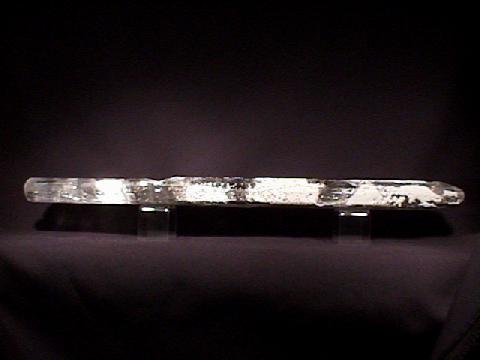
GYPSUM specimen gyp-37
$ 300.00
$ 300.00
Dims: 21.4 x 1.4 x 1.4" (54.4 x 3.6 x 3.6 cm)
Wt: 3 lbs., 0.9 oz. (1.4 kg)
Chihuahua, Mexico
A single, long Selenite crystal makes up this large cabinet specimen. It is in good condition, showing damage only where other, partly intersecting crystals were separated from it. These damage areas generally take the form of shallow geometric depressions that do not extend more than 0.3" beneath the outer surface of the crystal, and expose flat, clean surfaces that are evidence of the layering effect of its growth. Its monoclinic prismatic form is excellent, as all edges are well-defined and the faces are mostly clean and possess a bright pearly luster. Portions of each face are covered, however, by a dull white crust- this crust is made up of small, tight sprays of tiny Gypsum crystals that are heavily intergrown. There are also a few small but visible Gypsum crystals on the crusts, but these do not exceed 0.2" (5 mm) along any of their axes. The Selenite is colorless, transparent, and moderately clear, as it contains many internal fractures and inclusions. The most noticeable inclusions are thousands of tiny formations of brown hematite or limonite that likely have a dendritic habit. They are aligned in planes beneath the surface of the crystal and collectively form a large phantom that runs along 3/4 its length. Close examination at the termination of the phantom will reveal that there are actually 2 of them, at least one of which is accompanied by another layer of intergrown, tiny Gypsum clusters that were enveloped during growth. There is no host rock, of course.
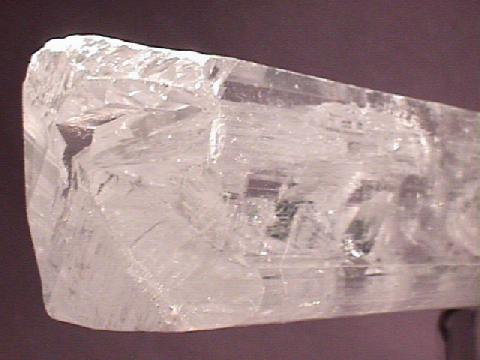

gyp-37 ($300.00)
Chihuahua, Mexico

GYPSUM specimen gyp-42
$ 60.00
$ 60.00
Dims: 8.7 x 4.5 x 2.4" (22.1 x 11.4 x 6.1 cm)
Wt: 2 lbs., 8.8 oz. (1.157 kg)
Chihuahua, Mexico
A substantial portion of the surface of this partial Selenite crystal has been cleaved, but this cleavage does not necessarily detract from its appearance. There are a few areas of noticeable damage besides the cleavage, but these are relatively minor. Its visible monoclinic form is excellent, and two large faces in particular are exceptionally clean, showing a dull pearly, almost silky luster. The Selenite is colorless, transparent, and very clear- only a few internal fractures and iridescent cleavage-oriented internal flaws are visible within. There is a smattering of a dark red-brown host rock present, but this looks more like a thin bit of crust.

gyp-42 ($ 60.00)
Chihuahua, Mexico
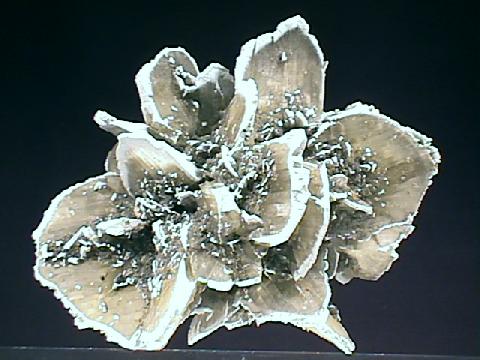
GYPSUM specimen gyp-46
$ 110.00
$ 110.00
Dims: 5.8 x 5.2 x 4.7" (14.7 x 13.2 x 11.9 cm)
Wt: 1 lb., 6.3 oz. (632 g)
Swift Current, Saskatchewan, Canada
A large cluster of radiating Selenite blades makes up this cabinet specimen. These blades range in size from 0.1 x 0.1" (3 x 3 mm) to nearly 2 x 2" (5 x 5 cm), and are generally in good condition, though many show minor damage to their edges. All have good monoclinic prismatic form, with well-defined edges and clean faces. All have a pale brown color and a dull pearly luster, but the edges of each crystal have been dehydrated, giving them a white color, a dull luster and a chalky consistency. They are likewise transparent and dimly clear, allowing one to see the parallel cleavage lines within. A few pebbles are intergrown with the blades, but there is no host rock present.

gyp-46 ($110.00)
Swift Current, Saskatchewan, Canada
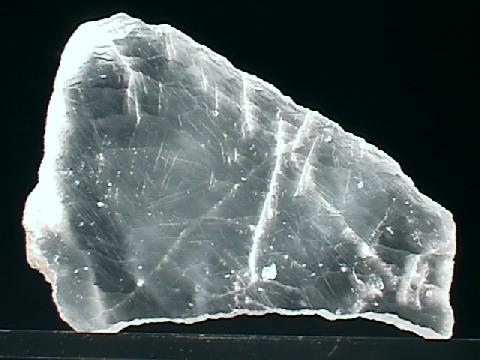
GYPSUM specimen gyp-47
$ 31.00
$ 31.00
Dims: 4.4 x 3.5 x 0.6" (11.2 x 8.9 x 1.5 cm)
Wt: 8.46 oz. (240.1 g)
northern peninsula, Michigan, U.S.A.
This hand specimen consists of a slice of a large columnar piece of Satin Spar, a variety of Gypsum that possessess a compact, fibrous habit. This slice is roughly polished on both cut faces, but many scratches are still visible. One can see evidence of its habit along the side faces, which are heavily striated. The Satin Spar is colorless and transparent, and though it contains many internal fractures, these are directionally aligned so that they provide little interference when viewing the piece through either of the polished faces. Thus, it is quite clear, enabling one to see print or designs very easily through it when it is placed on top of them. The optical effect is not quite the same as that of fibrous, compact ulexite, but it is similar.

gyp-47 ($ 31.00)
northern peninsula, Michigan, U.S.A.
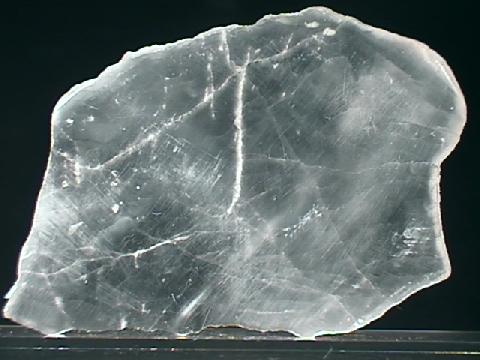
GYPSUM specimen gyp-49
$ 30.00
$ 30.00
Dims: 4.8 x 3.3 x 0.5" (12.2 x 8.4 x 1.3 cm)
Wt: 6.99 oz. (198.1 kg)
northern peninsula, Michigan, U.S.A.
This piece consists of a thin cut section of Satin Spar, a variety of Gypsum that is compact and fibrous. While the two "basal" faces of the piece have been polished, the edgeward surfaces have been left intact, showing these fibrous tendencies. The material is basically colorless and transparent, though it appears to be milky white in color and translucent from the side. The cut faces are still visibly scratched but have been partly polished, enough so that one can see print and images somewhat clearly through the piece if it were to be lain atop them. There is no host rock present.

gyp-49 ($ 30.00)
northern peninsula, Michigan, U.S.A.
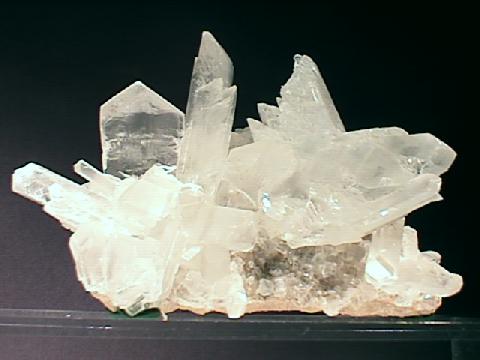
GYPSUM specimen gyp-53
$ 120.00
$ 120.00
Dims: 6.8 x 4.8 x 4.4" (17.3 x 12.2 x 11.2 cm)
Wt: 2 lbs., 10.0 oz. (1.191 kg)
Chihuahua, Mexico
Several intersecting Selenite crystals rest on the pale brown base of this cabinet specimen. These crystals are generally in fair condition, as most are visibly damaged and a few are severely so. The largest of these crystals has dimensions of 3.1 x 2.8 x 1.4" (7.9 x 7.1 x 3.6 cm) and occurs in the form of a "fishtail" twin (see the second image). A few other twins are visible on the piece, but the rest of the crystals have the classic monoclinic prismatic form with well-defined edges and clean faces that possess the standard pearly luster. All are colorless and transparent, and most are very clear, though the largest one is slightly cloudy. The base on which they rest appears to be made up of limestone, and has felt pads on portions so that it can be set upright without damaging the surface or the specimen.
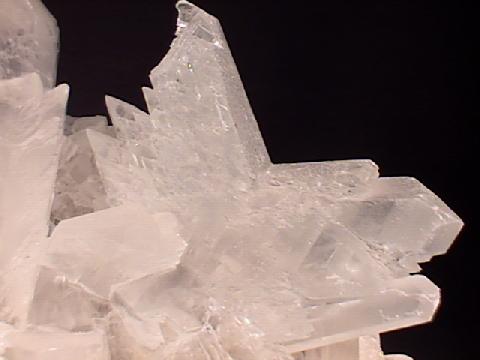

gyp-53 ($120.00)
Chihuahua, Mexico
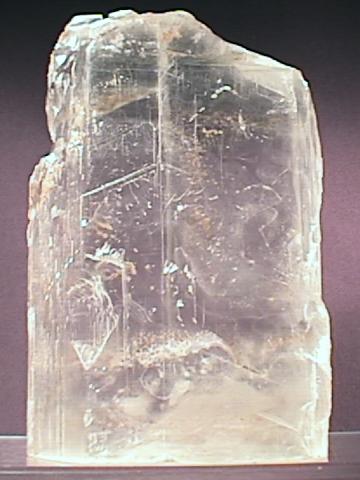
GYPSUM specimen gyp-55
$ 54.00
$ 54.00
Dims: 7.0 x 4.5 x 3.3" (17.8 x 11.4 x 3.3 cm)
Wt: 3 lbs., 2.0 oz. (1.419 kg)
Chihuahua, Mexico
This large specimen consists of a single, twinned Selenite crystal with a flat base cut into one end. It is in good condition, showing a few spots of only light damage, and it has good monoclinic prismatic form, with well-defined edges and clean faces that show subtle, complex patterns in certain areas. Its termination is very uneven, but one can still trace the twinning plane across it by sight. It is colorless, transparent, and moderately clear, containing a few planes in which muddy brown inclusions are trapped. A few small patches of this material are visible on the outside of the piece, but there is no actual host rock present. The piece stands up with moderate stability on its cut face. Such pieces are sometimes placed on a lighted base to form a decorative "lamp".

gyp-55 ($ 54.00)
Chihuahua, Mexico
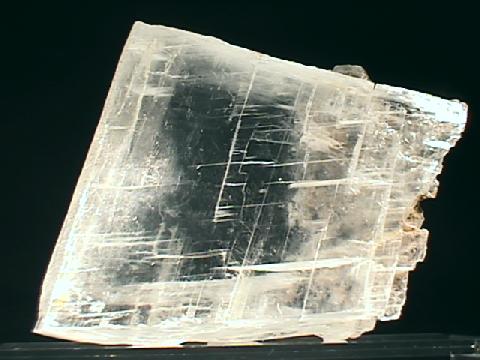
GYPSUM specimen gyp-56
$ 35.00
$ 35.00
Dims: 7.0 x 6.3 x 2.4" (17.8 x 16.0 x 6.1 cm)
Wt: 4 lbs., 6.1 oz. (1.989 kg)
Utah, U.S.A.
A large chunk of crystalline Selenite makes up this specimen. Though it appears to have been broken, none of its surfaces have the bright luster and smoothness that denotes fresh breakage. It is definitely crystalline, however, and has well-defined edges and striated but clean faces where applicable. It is colorless, transparent and moderately to very clear, and has a variable pearly luster. No base or host material is present.

gyp-56 ($ 35.00)
Utah, U.S.A.
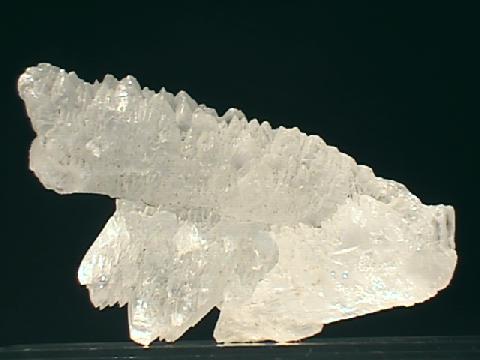
GYPSUM specimen gyp-57
$ 25.00
$ 25.00
Dims: 7.0 x 3.7 x 2.7" (17.8 x 9.4 x 6.9 cm)
Wt: 1 lb., 14. oz. (873 g)
Chihuahua, Mexico
This cabinet-sized specimen consists of a formation of fishtail selenite, a variety of Gypsum. The material is in fair to good condition, as it shows considerable visible damage in the form of scuffs and small cleavage areas. Its monoclinic form is excellent, however, showing a complex array of flat faces and straight edges. As is with most selenite specimens, this material is colorless, transparent and dimly to moderately clear, and has a pearly luster.
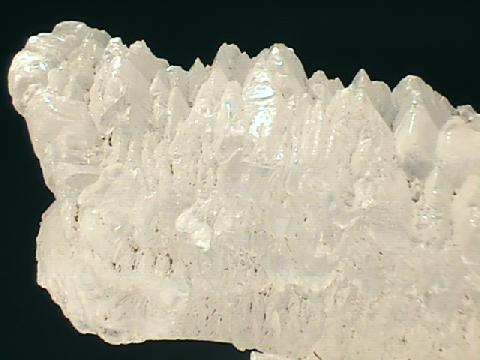

gyp-57 ($ 25.00)
Chihuahua, Mexico

GYPSUM specimen gyp-63
$ 25.00
$ 25.00
Dims: 1.5 x 1.4 x 1.3" (3.8 x 3.5 x 3.2 cm)
Wt: 1.0 oz. (28 g) w/ base
Red River Floodway, Winnipeg, Manitoba, Canada
Two "split" Gypsum blades extend from the base of much smaller, intergrown crystals of this large thumbnail piece. These crystals are in excellent condition, showing almost no human-induced damage and little natural damage. The larger of the two has dimensions of 1.0 x 1.0 x 0.4" (2.6 x 2.5 x 1.1 cm), and the smaller is only slightly smaller than that. Each has excellent monoclinic bladed form and shows evidence of splitting into two distinct crystals, though the process is incomplete. Their color is a dull, pale yellow and their luster is pearly to greasy. Both are transparent and moderately clear, containing a few internal fractures and inclusions. The base is made up of many smaller blades, but these are either broken or heavily intergrown. The piece is hot-glued to an acrylic base.

gyp-63 ($ 25.00)
Red River Floodway, Winnipeg, Manitoba, Canada
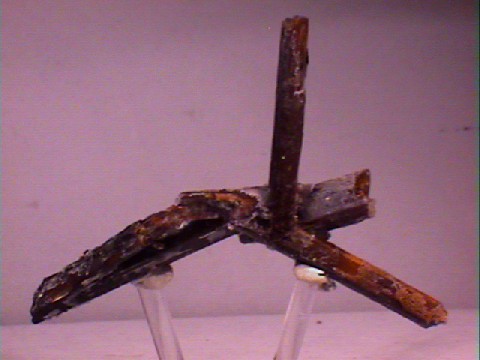
GYPSUM specimen gyp-64
$ 25.00
$ 25.00
Dims: 3.0 x 2.7 x 0.5" (7.6 x 6.9 x 1.3 cm)
Wt: 0.5 oz. (13 g)
Hilarion Adit, Agios Constantinos, Laurion, Greece
This cabinet piece consists of at least 5 intersecting Gypsum crystals. These crystals are generally in very good condition, showing no fresh breakage, and three of them even show definable terminations; two of these are completely intact. The longest one reaches about 2" (5 cm) in length. All show very good monoclinic prismatic form and have the standard pearly to vitreous luster of their specie. The crystals contain what appears to be a large quantity of included goethite or hematite, as their color ranges from rust-red to a deep brown. Their outer surfaces consist of a thin skin of clear selenite, however. At first I thought that they were epimorphs, but the physical properties of the Gypsum obviously extend completely through them.

gyp-64 ($ 25.00)
Hilarion Adit, Agios Constantinos, Laurion, Greece
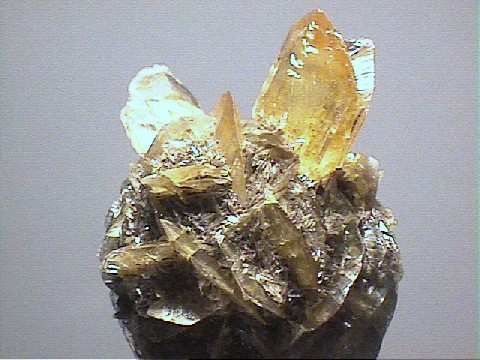
GYPSUM specimen gyp-62
$ 39.00
$ 39.00
Dims: 2.3x2.0x1.8" (5.7x5.2x4.5 cm)
Wt: 2.3 oz. (66g)
Red River Floodway, Winnipeg, Manitoba, Canada
This is a spherical aggregation of gypsum crystals, with a couple of larger protruding (and I think twinned) crystals. The color is a pale yellow, and while the ball is essentially an opaque jumble of translucent crystals, the largest crystal is transparent.

gyp-62 ($ 39.00)
Red River Floodway, Winnipeg, Manitoba, Canada
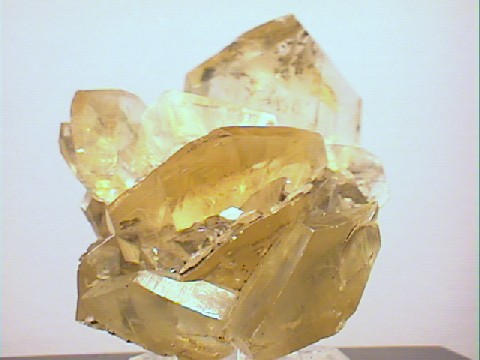
GYPSUM specimen gyp-65
$ 35.00
$ 35.00
Dims: 2.5x2.0x1.6" (6.4x5.2x4.0 cm)
Wt: 3.5 oz. (99.4g)
Red River Floodway, Winnipeg, Manitoba, Canada
All of the crystals in this gypsum specimen appear to radiate from a single point. The crystals are mostly transparent, and the color is a very pale yellow. There is minor damage to several points, and significant damage to one of them.

gyp-65 ($ 35.00)
Red River Floodway, Winnipeg, Manitoba, Canada
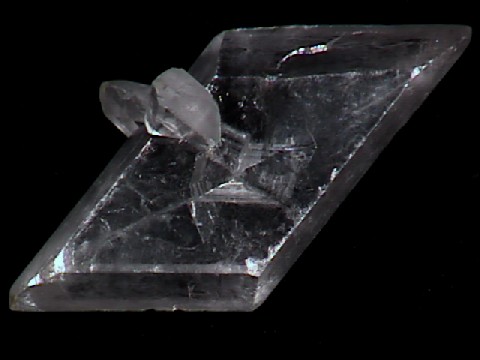
GYPSUM specimen gyp-66
$ 28.00
$ 28.00
Dims: 1.91x1.02x0.65" (4.85x2.58x1.65cm)
Wt: 0.55oz (15.5g)
Weisloch, Heidleberg, Baden, Germany
This is a very nice specimen of the colorless clear selenite variety of gypsum. It has one large nearly perfectly shaped crystal (a parallelogram with roof-shaped edges), two small intergrown crystals, plus a pyrimidal cavity. The point of the cavity, the bases of the two small crystals, and the center of the large one are all the same point in space. There are some dull black inclusions in the large crystal, as well as several internal fractures that reflect a rainbow interference pattern. The is a fairly small amount of damage, considering the softness of this mineral.

gyp-66 ($ 28.00)
Weisloch, Heidleberg, Baden, Germany
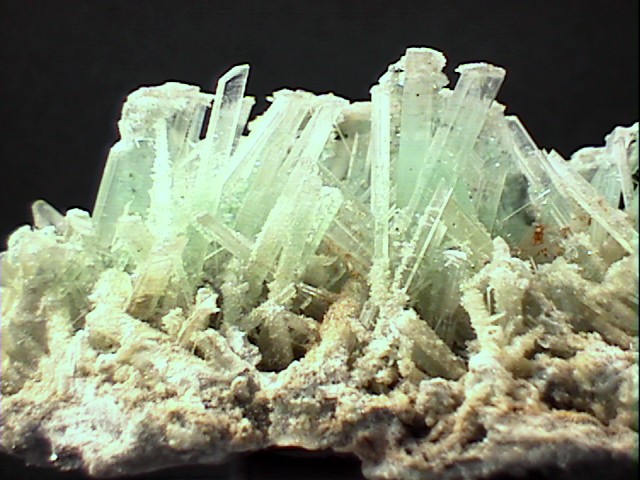
GYPSUM specimen gyp-67
$ 30.00
$ 30.00
Dims: 3.93x2.24x1.75" (9.99x5.70x4.45cm)
Wt: 5.62oz (159.2g)
Lubin, Poland
This is a beautiful and unusual gypsum specimen. The crystals are mostly long and prismatic blades with flattened hexagonal cross sections and slanted terminations. They are a pretty yet pale aqua green in color, with a luster that is vitreous in some areas and dull in others. A loupe reveals that the dull luster on some crystal faces is due to an overgrowth of extremely tiny gypsum crystals, many in tiny radial clusters. There is a base which appears to consist of more gypsum crystals, although they appear dirty and do not have the color and transparency of the larger crystals. Also, it is clear that these crystals formed in a crevice - the contact surfaces on both sides are clearly visible.
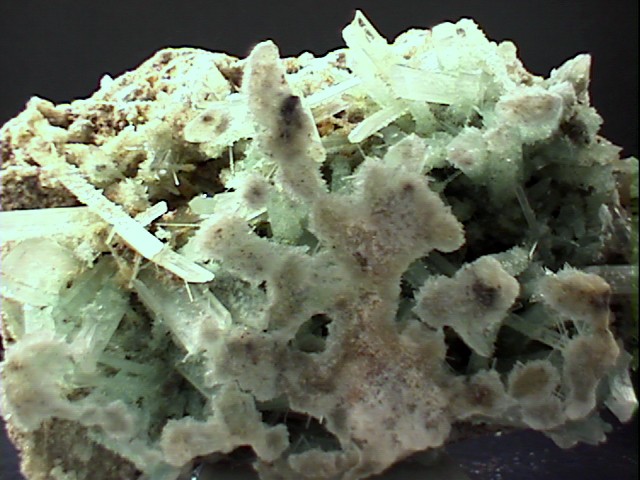

gyp-67 ($ 30.00)
Lubin, Poland

$ 120.00
Dims: 4.22x2.73x2.73in (10.71x6.93x6.93cm)
Wt: 20.04oz (568g)
Chihuahua, Mexico
This is a very well formed but unusually shaped gypsum crystal. It reminds be of a calcite scalenohedron, but it is distorted with some faces that are striated and rounded, and some surfaces are extremely flat. It is the shape of a hand-axe. There are a dozen or more small areas of minor damage, which could be "erased" with a carefulstream of water, but I prefer the crystal as it is. I do like this specimen, largely because of its unusual and aesthetic shape.


Chihuahua, Mexico